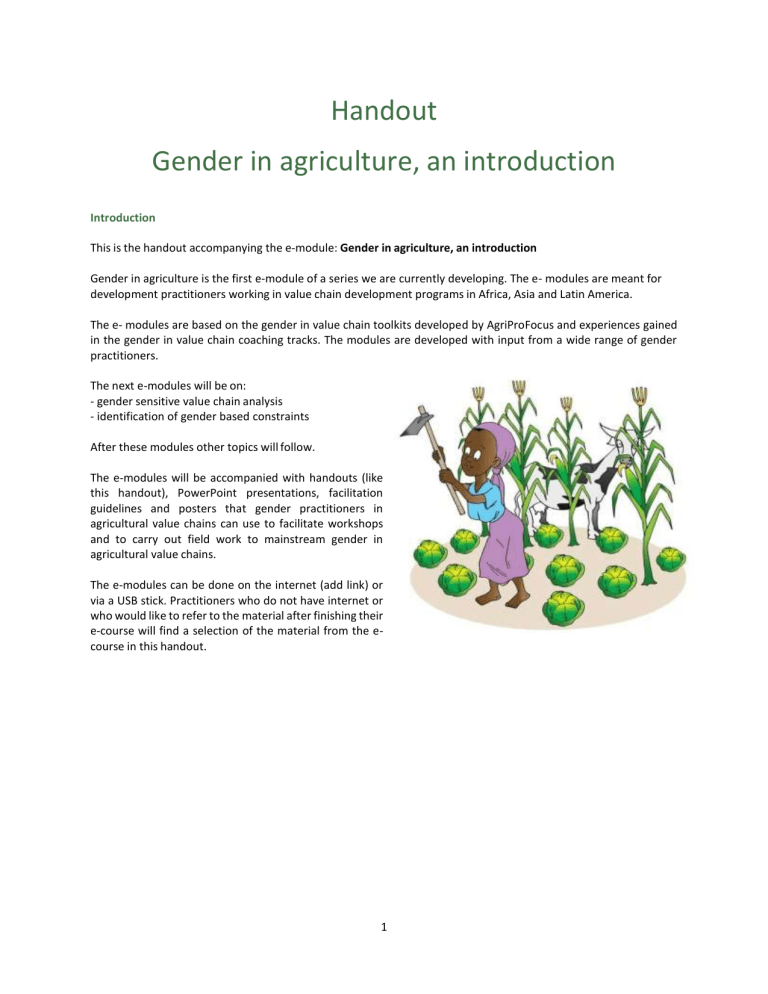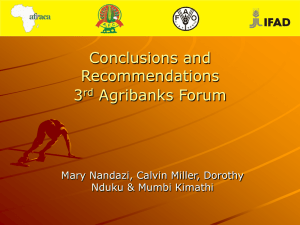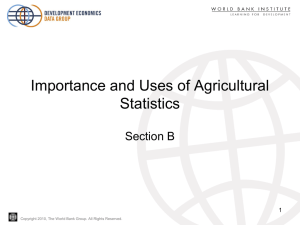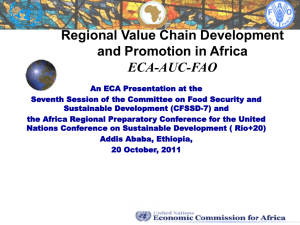Handout Gender in agriculture, an introduction

Handout
Gender in agriculture, an introduction
Introduction
This is the handout accompanying the e-module: Gender in agriculture, an introduction
Gender in agriculture is the first e-module of a series we are currently developing. The e- modules are meant for development practitioners working in value chain development programs in Africa, Asia and Latin America.
The e- modules are based on the gender in value chain toolkits developed by AgriProFocus and experiences gained in the gender in value chain coaching tracks. The modules are developed with input from a wide range of gender practitioners.
The next e-modules will be on:
gender sensitive value chain analysis
identification of gender based constraints
After these modules other topics will follow.
The e-modules will be accompanied with handouts (like this handout), PowerPoint presentations, facilitation guidelines and posters that gender practitioners in agricultural value chains can use to facilitate workshops and to carry out field work to mainstream gender in agricultural value chains.
The e-modules can be done on the internet (add link) or via a USB stick. Practitioners who do not have internet or who would like to refer to the material after finishing their e-course will find a selection of the material from the e- course in this handout.
1
Objective
Awareness raising on the importance of gender sensitive value chain development.
Direct target group
Gender in value chain Coaches (a coach can be internal or external to an organisation)
Ultimate target group
Coachees
Management of development organisations and private sector companies
Staff of the same organisations and businesses
Learning objectives:
At the end of the module the coach knows:
● How to facilitate a process to convince management and staff to work in a gender sensitive manner on agricultural value chain development
At the end of this module the coachees know:
● What is gender?
● What is gender sensitive development of agricultural value chains?
● What are the arguments for gender sensitive value chain development?
● What are the key elements of gender sensitive value chain development
Didactic Material
● E-modules for coachees
●
●
Handout for coachee
Facilitators guide and PowerPoint for coaches to facilitate a session with the management in the organisation at stake
● Facilitators guide and PowerPoint to facilitate a session with staff in the organisation at stake
2
Table of content
1.1
1.2
1.3
1.4
1.5
1.6
2.1
2.2
2.3
2.4
2.5
2.6
2.7
3.1
3.2
3.3
3.4
3.5
3
PART I. WHAT IS GENDER
1.1
The gender issue
On 8 March 2012, Michelle Bachelet, Executive Director of UN Women, called for women's equal participation in all spheres of life as fundamental to democracy, justice and economy:
"No enduring solution to the major challenges of today can be reached without the full and equal participation of the world's women in the political arena and economy, yet they face some of the worse inequalities in access to social
services, land and other productive assets, This deprives them, and the world of the realization of their full potential."
Bachelet is currently serving her second term as President of Chile. She is the first woman in her country to do so.
She is the first person since 1932 to win the presidency of Chile twice in open elections.
According to Michelle Bachelet, gender inequality deprives not only women but all humanity, men and women alike of the realization of their full potential.
If you agree with Michelle Bachelet, this course may help you to better underpin your arguments.
If you disagree with her, this course probably contains a lot of new information and insights for you. It may even lead you to change your opinion!
1.2
Gender roles in Agriculture
Pheona works in coffee production
Meet Pheona.
Women like Pheona have a crucial role to play in coffee production such as tending the coffee garden, picking, drying, sorting, etc. They do around 70% of the work in coffee farming on an unpaid family labour basis. On top of this productive role, they often have to grow food crops on a piece of land and have to tend the household chores. They are sometimes not able to support their husbands, because of lack of time or exhaustion
When women's work is not visible, nor valued, when women are not informed nor involved in decision-making on production, post-harvest handling or marketing, they feel de-motivated. Yet Pheona’s contribution is crucial to ensure enhanced productivity and quality.
Often, women like Pheona perform more tedious and time consuming tasks like weeding, and sorting coffee.
Men often perform tasks that require physical strength like preparing land and planting or technical know-how like pruning, pest and disease control,
Women are responsible for household chores, on top of the work in the coffee. They also take care of their vegetable gardens or grow food crops for household consumption and food security.
As this example clearly shows: disregarding women's stake in coffee farming reduces the benefits families gain from coffee production and directly affects the entire coffee value chain.
Source picture: http://www.fao.org/gender/infographic/en/
4
1.3
Knowing the farmer
Farmers can be men and women of all ages. Farmers are often seen as male and middle aged. In reality, women play a major role in agriculture both in food and cash production. But they are not visible and often overlooked.
If women had equal access to agricultural resources and services, food security would be greatly improved and societies would grow richer, and not only in economic terms.
Research has shown that many people underestimate the average age of the African farmer, which is over 45! Also there is evidence that many people overlook the important role women play in agricultural food and cash production. Women have less access to land, seeds and extension services, than their fathers and husbands who are more easily recognized as farmers.
In fact all these five people could be farmers, whether they are men or women, old or young, wear boots or fancy clothing. Perhaps the man on the right runs a very sophisticated flower business and the woman next to him could be a successful chicken breeder!
Source: FAO at Work 2010-2011
1.4
Gender access to resources
Do you know the figures?
Women comprise 43% of the agricultural labor force in developing countries
Female farmers receive only 5% of all agricultural extension services.
Only 15% of the world's extension agents are women.
Only 10% of the to aid for agriculture, forestry and fishing goes to women.
5
Because of cultural attitudes, discrimination and lack of recognition in their role in food production, women enjoy limited to no benefits from extension and training in new crop varieties and technologies.
These figures are alarming! Women have considerable less access to agricultural resources than their husbands and fathers. This is not only true for women’s access to extension services, but also for their access to land, seeds, fertilizers, technologies and credit.
How many female extension officers are
present in your organization?
Do women receive training and support?
Do women have access to land, seeds,
technologies and credit?
Source: FAO statistics
1.5
Gender versus sex
Sometimes it is hard to understand exactly what is meant by the term "gender", and how it differs from the closely related term "sex".
Unlike sex that refers to biological and physiological characteristics that define women and men, gender is a social construct. It may change and develop.
A woman will always be a woman, but what she is allowed to do or not
(e.g. owning land) or is supposed to look like (e.g. small and slender) in order to be respected in society, is culturally defined.
Hence gender roles may develop over time or can be deliberately changed. The latter requires convincing arguments and a group of advocates lobbying for the desired changes. This is what drives the
"gender movement".
1.6
Gender goals
In every society, there are activities and responsibilities which are considered typical for women or for men. This division of social roles between men and women results in differences in power and access to resources. In many societies these differences result in a structurally better position for men compared to women, when it comes to decision-making power and access to resources and benefits.
Given this reality, gender programs have three interrelated gender goals:
Oh, this explains why men grow cash crops and women grow food crop!
Gender equality
Gender equity
6
Women empowerment
Gender equality: equal access to power, resources and benefits for men and women. This does not mean that women and men should become the same!
Gender equity : To give women a fair chance to make progress towards a position equal to men in society, special measures/support for them are justified.
Women’s empowerment: To work together to transform gender relations in society, we need strong and self-confident men and women
PART II. Why is gender mainstreaming in value chain development important?
2.1
Why address gender issue in value chain?
There are three main arguments for paying attention to gender roles and gender relations in agricultural value chains.
1.
Business arguments, not recognizing women creates a missed business opportunity. The World Bank argues that gender inequality has high economic costs, leads to wasted human resources and missed opportunities for innovation.
2.
Social justice arguments, every person, male or female has the same basic rights as a human being. Both men and women should benefit from development activities. Often women are discriminated.
3.
Poverty alleviation and food security arguments, woman are important actors to achieve poverty alleviation.
This is illustrated in the short film on coffee (link)
Source: KIT, Agri-ProFocus and IIRR. 2012, Challenging chains to change: gender equity in agricultural value chains
2.2
A slogan for gender mainstreaming
Apparently it takes an extra effort to make sure that women and men benefit equally from development efforts. We call this gender mainstreaming. UNECOSOC's definition of Gender mainstreaming is:
"Gender mainstreaming is the process of assessing the implications for women and men of any planned actions, including legislation, policies or programs, in all areas and at all levels.
It is a strategy for making women’s as well as men’s concerns and experiences an integral dimension of the design, implementation, monitoring and evaluation of policies and programs in all political, economic and societal spheres, so that women and men benefit equally and inequality is not perpetuated. The ultimate goal of mainstreaming is to achieve gender equality."
Know her, design for her, be accountable to her" is the most far reaching slogan. It summarizes how to empower women to the extent that they can level men in terms of control and opportunities.
Source: KIT, Agri-ProFocus and IIRR. 2012, Challenging chains to change: gender equity in agricultural value chains
7
2.3
Gender sensitive value chain development
Applying gender mainstreaming to value chains comes down to gender-sensitive value chain development.
The diagram shows the five stages of the value chain development project cycle. For each stage, the AgriProFocus gender toolkit provides tools, not only to analyze the value chain from the gender perspective, but also to work with groups of chain actors towards gender balance and better functioning of the chain.
2.4
Gender programs are good for business
In the Rift Valley in Kenya, women perform important tasks in dairy farming, but this was not given due recognition in the way the sector operates.
Elizabeth Chepchirchir Sang, is dairy farmer in the Rift
Valley in Kenya. Her family business and cooperative did very well the last 5 years, due to the successful Keya Dairy development program
Under the Kenya Dairy Sector Competitiveness Program multiple activities were implemented leading to the uptake of new practices and inputs by men and women:
Farmer households (men, women) got organized into cooperatives whereby quotas were set for women’s leadership positions.
Technical and organizational training & on site learning was designed and executed in line with women’s needs and interests.
Women were also stimulated to become trainers and service providers, e.g. for AI (artificial insemination) technology.
This all stimulated uptake of new practices among women farmers whereas the new skills and jobs increased women’s confidence and income.
8
Commercial input supplies e.g. technology, loans or fodder trees were promoted and made available to households. This had positive effects on cattle ownership for women and joint decision making and task sharing in dairy.
Introduction of biogas plants with cow dung helped to reduce firewood needs. These supportive measures helped, among other things, to improve the balance between dairy work and household tasks for women. Read more about this program (make pdf accessible).
This contributed to a general increase in production and quality of milk.
2.5
Business case for gender
In general women can deliver the same output as men. When gender role-division in society prevents women and men from reaching their full potential, there is a business case for gender- sensitive value chain development. Research in the Manduvira sugar cane cooperative in Paraguay revealed the following business arguments for gender sensitive value chain development: a) when given the opportunity, productivity of women equals that of men; b) female farmers are early adopters of new improved farming techniques; c) women succeed in non-traditional job; d) gender diversity in membership and leadership strengthens the organization.
The income of farmer households increases with a more rational
distribution of tasks between men and women
2.6
Taking the household as a starting point
In Luwero district Uganda, Robusta coffee farmers were supported by the Hans R Neumann Stiftung
(HRNS). HRNS took the social justice approach. They started a program on household level.
In the film, Luwero farming couples talk about the changes. Watch the film.
The participants of this program analyse how the gender role division in their households affects productivity and income. Hence they naturally conclude that more balance is needed.
During the course, couples may express commitment to shared decision-making and a willingness to share their experience with other members of their community. These couples are identified as 'change agents'. They receive ongoing coaching from HRNS, but are otherwise entirely self-motivated. Drama shows and community dialogues further help to create awareness and disseminate key messages
2.7
Effect of the household approach
In 2013, Terrillon and Joynson conducted a study in the HRNS coffee program in Uganda to assess the impact of gender mainstreaming at household level.
9
The effects they found are visualized in the drawings:
The survey results indicate
1.
That the households in the gender program are more secure in terms of household food requirements.
2.
The percentage of households experiencing food insecurity in 2012 is lower in households benefiting from the gender project compared to the control group and
3.
They are saving on average slightly more.
4.
The quality of houses in terms of type of roofing material and type of wall is marginally better for households that have participated in gender activities compared to those that have not.
Source : Terrillon Jacqueline and Joynson-Hicks Emma, 2013, « Building a Business case for gender equality and sustainable coffee value chains through the household approach. »
PART III. How do you mainstream gender in agricultural value chains?
3.1
Is gender on the agenda?
An organisation can take a different approach towards gender. The Bill and Melinda Gates Foundation define the following three:
Gender Transformative
Some programs account for gender differences and inequalities from the start, with a sound strategy for transforming the relationships between women and men with an emphasis on equity.
Gender Aware
Many more projects have a sense of how women and men farmers will participate in their projects, and work with us to create high-impact programs that meet both women’s and men’s needs. These projects result in designs that ensure that both women and men benefit, and that neither are harmed. We consider these programs gender aware.
Gender Neutral
Lastly, there are projects that do not account for the differences between women and men and do not consider how women and men may be marginalized or may not benefit from projects. We consider these programs gender neutral or gender blind, they are typically less effective in their design.
10
Based on: Bill and Melinda Gates Foundation, February 2012 ‘Creating Gender-Responsive Agricultural Development Programs’
An orientation document
3.2
Strong stance on gender
The Bill and Melinda Gates Foundation takes a strong stance on gender. That means they aim for an ultimate transformation of gender roles towards a more equitable division of tasks and benefits between men and women.
Gender aware programs acknowledge the different positions and roles in society of men and women. They have a strategy for how men and women can benefit from the program, each in their own way and that harms neither.
Gender transformative programs have a more ambitious gender goal: they not only acknowledge the different positions and roles of men and women in society, but also aim to transform these so that relations between women and men become more equitable. Programs which do not take into account the different positions and roles of women and men in society are called gender neutral or gender blind
The Gates foundation wants to move away from gender neutral agricultural support. They support projects that are gender aware and gender transformative
3.3
Gender transformative and gender aware activities
The Landesa project in India found that the names of women do not appear on land rights documents
(called pattas) and daughters are often not included as co-inheritors on these documents.
Imagine you are in the design phase of a new program to be funded by the Bill and Melinda Gates Foundation. Their slogan is: "design for her!" and they expect the design to include gender transformative elements.
Gender transformative elements in your design change people's perceptions and convictions about the division of roles and rights between men and women - in this case, focusing on land rights for women and girls. Changing perceptions and beliefs requires a package of related activities which build on each other: debates between men and women about the traditional division of roles, rights and income, getting the support of local leaders to change certain customs, laws and/or practices.
Gender aware elements focus on men and women as separate groups without aiming to change their mutual relations. Typical gender aware elements are 'income generating activities for women' and gender specific extension programs.
3.4
Measuring success
Value chain facilitators focus on gender issues to achieve results in one or more of the following impact areas:
1) business: increase in production and profits for value chain actors
2) social justice: equal rights, safety and liberty for women and men
3) food security: increase in household food security
11
Below, six important indicators are listed. Each indicator provides information about the success in one or more impact areas. For each impact area, tick the two indicators which are the most relevant for measuring success in that area.
Business indicators concern increased production and margins for actors along the chain, such as cooperatives and processors.
Justice indicators give information Stunting is caused by structural undernourishment. Food in poor households is mainly catered for by women, so more income for women means that children in poor households will be better fed.
Beware! An improved score on a chosen indicator is a good sign, but not enough to measure your program's results.
Often the real challenge is to convincingly demonstrate that improved indicator scores are the result of your program, and were not caused by other accidental factors, like a drop in food prices or a growing economy.
3.5
Personal action plan
Consider the suggestions for action below.
What will you do now that you have almost completed this introductory?
Contact Agriprofocus to see how they could help us improve our gender approach
Just implement some great ideas I got from this course
Propose to my team we all do this course and then have a meeting to discuss further actions
Organize a session to discuss the gender strategy of my organization
Collect and share some good practices within my organization
Share the link to this e-course with some people I think will be interested
You achieve more if you work in a group of people who share your values and who also feel the position of women in the agricultural value chains should improve.
12







